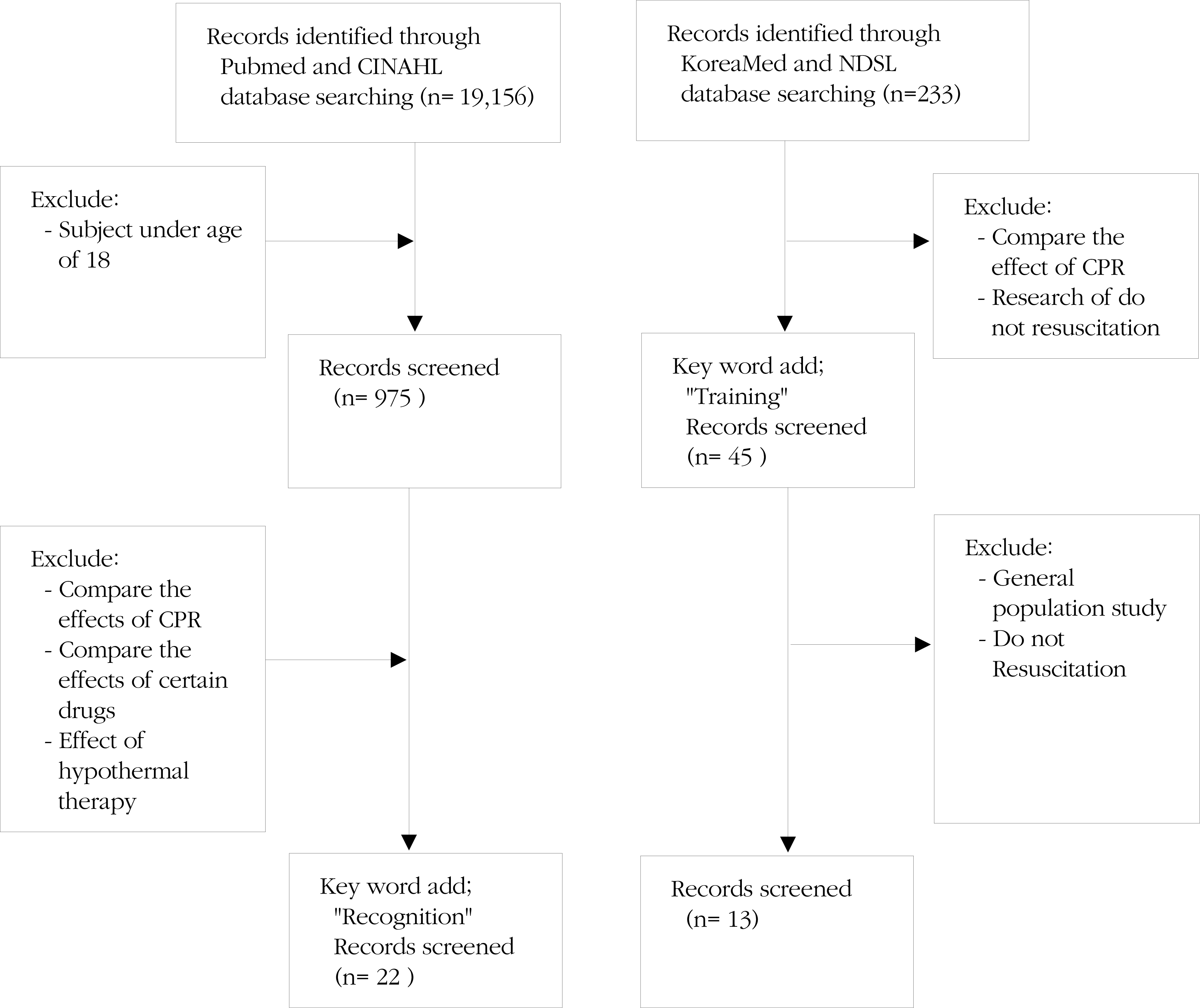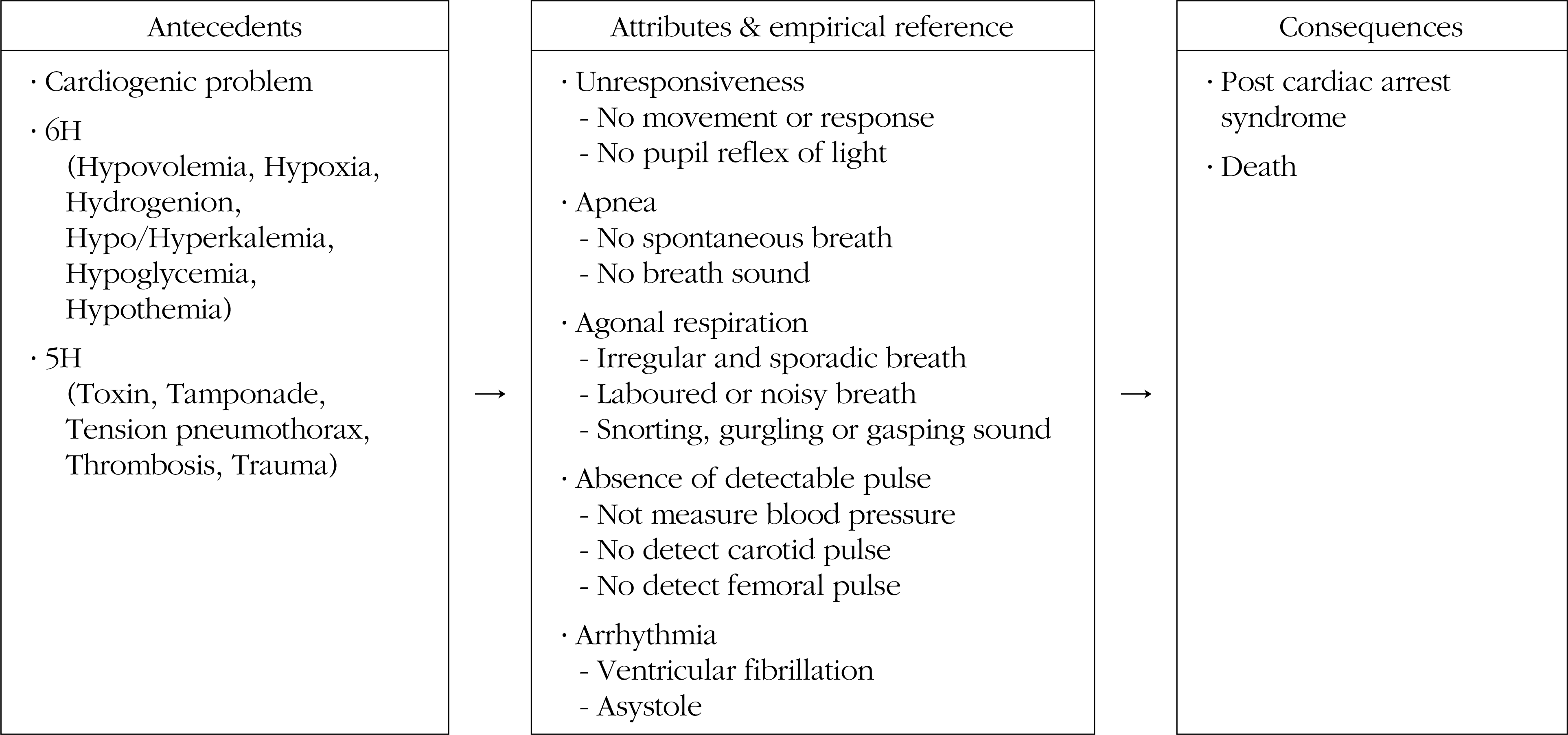Abstract
Purpose
Cardiac arrest has multiple characteristics that need to be approached as an integrated method according to the various changes in the body system. This study was performed to develop a useful guideline for early detection of cardiac arrest by revealing the attributes of cardiac arrest through a concept analysis.
Methods
This study was conducted according to the Walker and Avant's concept analysis method. Systematic literature review and in-depth interview with nurses who experienced cardiac arrest situation were conducted. Based on the literature reviews and in-depth interviews with nurses, the attributes and the empirical referents of the concept of cardiac arrest were elicited.
Results
The definable attributes of cardiac arrest were 1) loss of consciousness, 2) abnormal respiratory condition, 3) abnormal cardiovascular signs. Cardiac arrest was found to occur by several antecedents such as cardiac problem, non-cardiac problem, or general problem, whereas ischemia and re-perfusion injury, which can lead to multiple organ failure and death, were derived as consequences.
Conclusion
In this study, the concept analysis eliciting attributes and empirical referents is found to be useful as a guideline for understanding and managing cardiac arrest. Based on these findings, clinical providers are expected to make a precise and rapid decision on cardiac arrest and respond quickly, which may increase survival rate of the patients underwent the arrest event.
REFERENCES
American Heart Association. 2010a. Guidelines CPR & ECC. Dallas, TX: American Heart Association.
American Heart Association. 2010b. BLS for healthcare provider student manual. Dallas, TX: American Heart Association.
American Heart Association. 2010c. Advanced cardiovascular life support provider manual. Dallas, TX: American Heart Association.
Chan P. S.., Nallamothu B. K.2012. Improving outcomes following in hospital cardiac arrest. The Journal of the American Medical Association. 307:1917––1918.
Charles D. D.., Jerry P. N.., Jasmeet S.., Kjetil S.., Rudolph W. K.., Gary B., et al. 2010. European resuscitation council guidelines for resuscitation 2010. Resuscitation. 81:1305––1352.

Cho H. S.2013. Relationship between cardiopulmonary resuscitation knowledge, professional attitude, and job performance: A descriptive analysis of medium-to small-sized hospital nurses. Unpublished master's thesis. Ajou University, Suwon.
Christian V.., Manya L. C.., Katarina B.., James D.., Maaret C.2011. In out-of hospital cardiac arrest patients, does the description of any specific symptoms to the emergency medical dispatcher improve the accuracy of the diagnosis of cardiac arrest:. A systematic review of the literature. Resuscitation. 82:1483––1489.
Hajbaghery M. A.., Mousavi G.., Akbari H.2005. Factors influencing survival after in-hospital cardiopulmonary resuscitation. Resuscitation. 66:317––321.

Ji J. G.2000. Medical terminology dictionary. Anyang: Academia.
Jun H. C.2006. Education effect of CPR and external defibrillator training program for nursing staff. Unpublished master's thesis. Gachon University, Incheon.
Jung J. Y.., Chung Y.2010. Development of a prehospital protocol on cardiopulmonary resuscitation of 119 emergency medical technicians. Korean Institute of Fire Science & Engineering. 24(2):185––193.
Kim S. S.., Kim B. J.2006. Outcome of in-hospital cardiopulmonary resuscitationaccording to the in-hospital ustein style in a general hospital. Clinical Nursing Research. 11:177––192.
Kim E. J.., Lee K. R.., Lee M. H.., Kim J. Y.2012. Nurse's cardiopulmonary resuscitation performance during the first 5 minutes in in-situ simulated cardiac arrest. Journal of Korean Academy Nursing. 42(3):361––368.

Kim J. Y.., Jun S. S.., Kim D. H.., Choi S. S.2008. Knowledge and attitude toward BLS and provided CPR education among nurses at general wards in Pusan. The Korean Journal of Fundamentals of Nursing. 15(2):143––152.
Kobayashi L.., Lindquist D. G.., Jenouri I. M.., Dushay K. M.., Haze D.., Sutton E. M., et al. 2010. Comparison of sudden cardiac arrest resuscitation performance data obtained from in-hospital incident chart review and in situ high-fidelity medical simulation. Resuscitation. 81:463––471. http://dx.doi.org/10.1016/j.resuscitation.2010.01.003.

Korean Association of Cardiopulmonary Resuscitation. (KACPR). 2011. Korea guideline for cardiopulmonary resuscitation. Seoul: Author.
Korea Centers for Disease Control & Prevention. 2011. Development of guidelines for citizens' action to sudden cardiac arrest. Retrieved June 30, 2013 from. http://www.cdc.go.kr/CDC/info/CdcKrInfo0210.jsp?menuIds=HOME001-MNU1155-MNU1083-MNU1375-MNU0566&cid=22002.
Kwon Y. O.2012. Task analysis of ICU nurse about CPR. Unpublished master's thesis. Seoul National University, Seoul.
Lee J. A.., Park I. S.2003. The experiences of nurses in emergency situation.Chungnam Journal of Nursing Academy.
Marsch S. C.., Tschan F.., Semmer N.., Spychiger M.., Breuer M.., Hunziker P. R.2005. Performance of first responders in simulated cardiac arrest. Critical Care Medicine. 33:963––967.
Merchant R. M.., Yang L.., Berker L. B.., Berg R. A.., Nadkarni V.., Nichol G., et al. 2011. Incidence of treated cardiac arrest in hospitalized patient in the United States. Critical Care Medicine. 39:2401––2406.
Nolan J. P.2011. Optimizing outcome after cardiac arrest. Current Opinion in Critical Care. 17:520––526.

Nolan J. P.., Soar J. S.., Perkins G. D.2012. Cardiopulmonary resuscitation. British Medical Journal. 345:e6122. http://dx.doi.org/10.1136/bmj.e6122.

On Y. G.2006. ECG for nurse. 2nd ed.Seoul: Daehakseo-won.
Park C. W.., Ok T. G.., Cho J. H.., Cheon S. W.., Lee S. Y.., Kim S. E., et al. 2005. A study of the effectiveness of CPR training to the personnels of nursing department in the hospital. Journal of the Korean Society of Emergency Medicine. 16(4):474––480.
Ruzman T.., Tot O. K.., Ivic D.., Gulam D.., Rutman N.., Burazin J.2013. In-hospital cardiac arrest: Can we change something?. The Central European Journal of Medicine. http://dx.doi.org/10.1007/s00508-013-0409-0.
Sandroni C.., Nolan J.., Cavallaro F.., Antonelli M.2007. In-hospital cardiac arrest: Incidence, prognosis and possible measures to improve survival. Intensive Care Medicine. 33(2):237––245. http://dx.doi.org/10.1007/s00134-006-0326-z.

Walker L. O.., Avant K. C.2004. Strategies for theory construction in nursing. 4th ed.Norwalk, CT: Princeton Hall.
Yu J. S.., Choi H. K.., Whang J. H.., Kim B. J.., Oh H. S.., Kim J. W., et al. 2007. Development of a nursing protocol on CPR for non-traumatic adults in emergency setting. Clinical Nursing Research. 13(1):113––125.
Table 1.
Attributes and Contents of Cardiac Arrest in Literature Review
Table 2.
Attributes of Cardiac Arrest in Field Work




 PDF
PDF ePub
ePub Citation
Citation Print
Print




 XML Download
XML Download